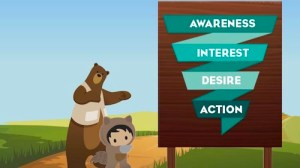The sales funnel metaphor is somewhat misleading; in real life, the process never goes as smoothly as liquid down a funnel. In the last decade, digital marketing, artificial intelligence (AI), and CRM have drastically changed the process of converting new leads into customers. Given this, it’s increasingly important that business-to-business (B2B) sales and marketing teams are aligned in their views on a sales funnel strategy and lead generation as a whole.
This article answers some common questions, including:
-
How is the sales funnel defined?
-
Why is the sales funnel still relevant?
-
How do you align sales and marketing in sales funnel stages?
-
How is the sales funnel changing?
-
How do you manage and optimise the sales funnel?
-
How do you balance human skills with data insights throughout the sales funnel?
A simple definition of a traditional sales funnel
A sales funnel represents the ideal path companies hope buyers take to become customers. Most companies use the funnel concept as a method to track prospects as they move through sales stages and to align marketing and sales targets, activities, and processes. (Some may also refer to this as a purchase funnel or conversion funnel.)
The sales funnel is one of the most fundamental concepts in sales and marketing. The top of the funnel signifies the goal of every business — to generate as many leads as possible — while the narrow bottom reflects how many of those leads are converted to customers by the end of the sales process.
Stages of a sales funnel can vary, but a traditional model follows these phases:
-
Awareness
-
Interest
-
Desire
-
Action
Of course, prospects’ behaviour is rarely this simple or linear.
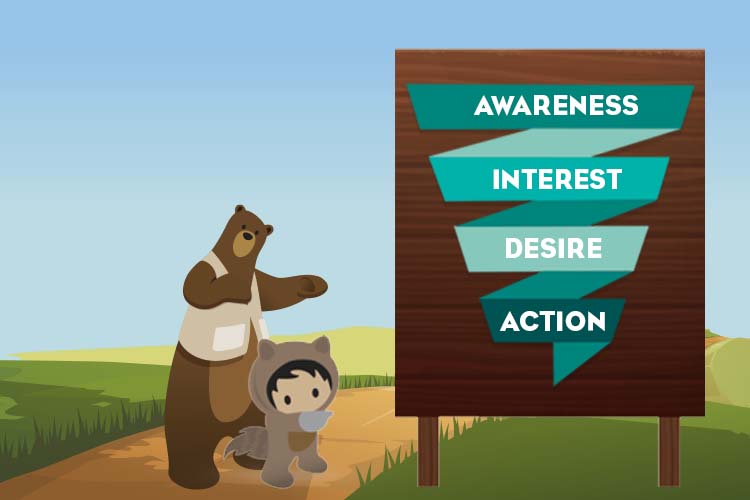
Why is a B2B sales funnel still important?
The sales funnel has been used by companies to manage internal sales stages for more than 100 years. At the top of the funnel, prospects may not be even close to making a purchase. However, they might be “qualified” based on actions they’ve taken — such as registering for a webinar, attending an event, or downloading an e-book.
Prospects progress down the funnel as they become aware of your products or services through interactions with sales representatives, or marketing and sales materials, and their interest grows — until, finally, some convert and become customers.
Having a well-defined sales funnel helps you understand your prospects’ knowledge of and interest in your products or services. That’s why tracking prospects through the funnel can determine how each should be approached (via what products or services they should be pitched or what content you should direct them towards) at any point in time.
Getting this timing right prevents losing prospects by bombarding them with too much information or giving them the hard sell too early. This is why moving prospects through the funnel is often called “nurturing.” Seventy-eight percent of business buyers seek salespeople who act as trusted advisors with knowledge of their needs and industry. Prospects should ideally only receive the information and sales help they need when they need it.
A prospect’s position in the funnel can help frame the type and frequency of campaigns needed to spark or maintain their interest. It can also help the sales team prioritise leads or suggest the most suitable answers to prospects’ questions or concerns.
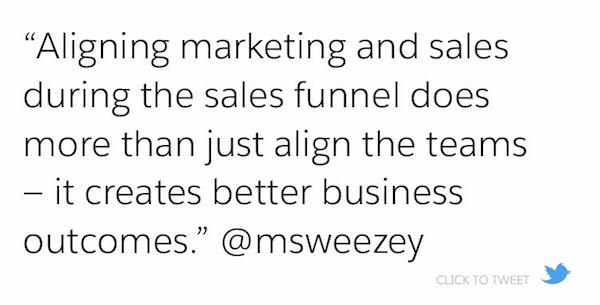
“Aligning marketing and sales during the sales funnel does more than just align the teams — it creates better business outcomes,” said Mathew Sweezey, Principal of Marketing Insights at Salesforce. His stance is validated by a SiriusDecisions study that found brands with tightly aligned sales and marketing operations achieve 24% faster three-year revenue growth and 27% faster three-year profit growth. The three easiest ways to ensure marketing and sales alignment will succeed is a common language, co-created shared programs, and a policy to abide by a service level agreement.
First, a common language needs to be set up to ensure marketing knows when a lead should be moved from marketing’s control, and placed in the sales funnel. There are two terms, “marketing-qualified lead” (MQL) and “sales-qualified lead” (SQL) or “sales-accepted-lead,” which all sales funnels must embrace to keep both teams aligned. When marketing has a lead ready to talk to sales, the lead should be marked as an MQL, meaning marketing has gotten it to the point where they believe sales should take over. If sales agree the lead is sales-ready, they accept the lead and move it from MQL to SQL (or SAL), and the handoff is complete. If not, the lead goes back to marketing.
The definitions of MQL and SQL (SAL) should be spelled out, and agreed upon, in a service level agreement (SLA). The SLA outlines the terms of how sales and marketing will work together. The SLA should define what MQL and SQL look like, as well as state the time frame and process each team must follow. For example, an MQL has reached a score of 75 through a combination of content engagement and web engagement and fits the ideal customer profile. It must be accepted by sales or sent back to marketing within 24 hours of being assigned. The SLA should be drafted together by both marketing and sales leadership and signed off on by both parties.
Beyond terms and process, one of the best ways brands can align both sales and marketing is through shared programs such as account-based marketing (ABM) and lead nurturing. In 2018, Salesforce Research found high-performing marketing organisations to be 1.5x more likely to use ABM methods, and 1.9x more likely to use lead nurturing than underperforming marketing organisations. They are “shared programs” since both marketing and sales should work together to create them. Marketing handles the technology and setup while sales pick the targets and help create the content. Sharing in the creation of the programs allows sales to feel ownership of the programs, increasing their use and overall effectiveness.
How is the sales funnel changing?
The changing nature of marketing and selling means sales funnels must continually adapt.
As Michael Bosworth, author of Solution Selling, points out in the “Story of Sales” documentary, sales used to be about convincing, persuading, overcoming resistance, handling objections, and closing the sale.
“Today, my definition of selling is helping [people]. It’s helping your customer achieve a goal, solve a problem, or satisfy a need,” Bosworth said.
The ways in which prospects and customers interact with businesses are also changing. Email, social media, and other digital channels are now preferred by many. Arranging phone calls and in-person visits has become harder.
However, video conferencing and other apps offer an opportunity to engage prospects at a time and place that suits them. In fact, 60% of sales reps say they spend more time selling virtually than they did in 2015, according to the third edition of Salesforce’s global “State of Sales” study. Meanwhile, 52% of sales reps say they spend the same amount of time or less meeting with customers in person.
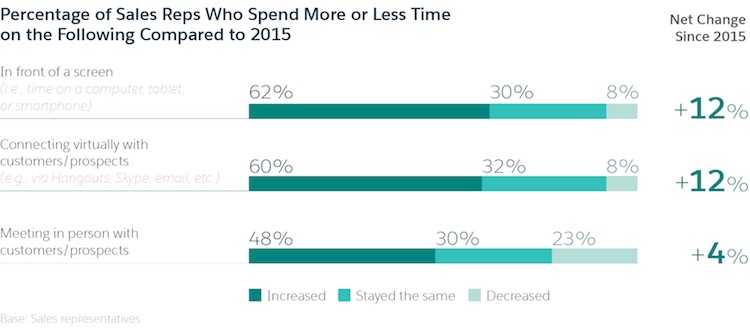
Digital tools such as mobile apps are fast becoming essentials. Sales managers and executives expect the adoption of mobile sales apps will jump 70% by 2020 — perhaps to cater to the 73% of business buyers who say on-demand engagement is very important for winning their business.
Sales funnels have become more complex
Sales funnels have become more complicated and demanding due to the increase in digital channels and other factors.
B2B companies now face similar expectations and challenges as those that sell to consumers. For example, 82% of business buyers now want the same experience as when they buy for themselves, while 79% say it’s easier than ever to take their business elsewhere.
Sales and marketing teams need to adapt to these increasing demands. They have to work more closely together. While the marketing team still hands leads to the sales team at a point in the funnel, they have to stay involved to maximise customer retention and advocacy. The sales team needs to be involved early on, providing the benefits of their customer knowledge to help increase qualified leads and conversions.
Analytics is now an essential sales funnel tool
Perhaps the biggest change to the sales funnel in the last 20 years is the availability and use of data. In the “State of Sales” research, analytics and sales reporting top the list of technologies used, with 68% of teams receiving data insights on sales, customers, and prospects.
Data insights are changing how sales and marketing teams make decisions. Sales reps now rely less on intuition in pursuing opportunities. Data analysis of “propensity to buy” is now the most popular method of prioritising leads — in fact, it’s twice as popular as intuition.
“Time is money for a rep,” said Tony Rodoni, Salesforce EVP, Commercial Sales, and Market Readiness. “You need to know the most important thing to do right now, and what to do next. If you’re not clear on which opportunities are accurate, you’re relying on your memory to know which ones need work. As you take on a bigger book of business, with more opportunities, quarter after quarter, relying on your own memory means mistakes and wasted time.”

The “State of Sales” also compares the habits of high performers (sales teams that have significantly increased year-over-year revenue) with underperformers (those with lower revenue). It reveals that high performers are 1.6x more likely to prioritise leads based on data analysis than underperformers — and half as likely to use intuition.
How to manage your sales funnel
Managing your sales funnel boils down to two tasks. First, your sales funnel strategy must be reassessed from time to time and updated to reflect changes that have occurred in the sales funnel.
Second, your sales funnel needs to be constantly optimised to ensure prospects’ sales journeys aren’t too rushed or too long and convoluted. Organisations can also optimise their use of resources by improving the efficiency of sales and marketing teams.
Data insights are again the key to funnel optimisation. Three other data-driven technologies follow analytics and sales reporting as the most popular sales tools: account and contact management (65%), sales forecasting tools (56%), and customer relationship management (CRM) systems (58%). The latter is a particularly crucial tool for optimisation, enabling your business to organise all customer-related data in a central location.
Salespeople are also using data to better understand a prospect’s relationship with their company. Three-quarters of salespeople say data on prospects’ propensity to buy more helps them prioritise leads and opportunities.
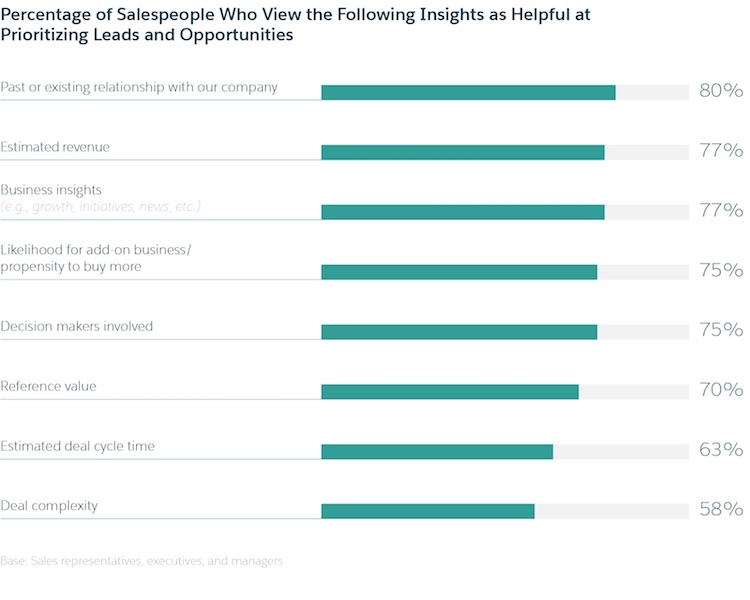
This suggests a shift from the traditional sales and marketing dynamic to one where the focus is on the value of leads, rather than the volume.
Many businesses miss opportunities to optimise their sales funnel
For example, “State of Sales” reveals significant gaps between what data-driven tools sales teams have and what they need.
Only 46% of sales reps receive data insights on customers’ propensity to buy. But of those reps, 85% say this makes them more effective in their job. And just 34% of reps receive alerts to key actions required to advance a sales opportunity, but 85% of them say these alerts make them more effective.
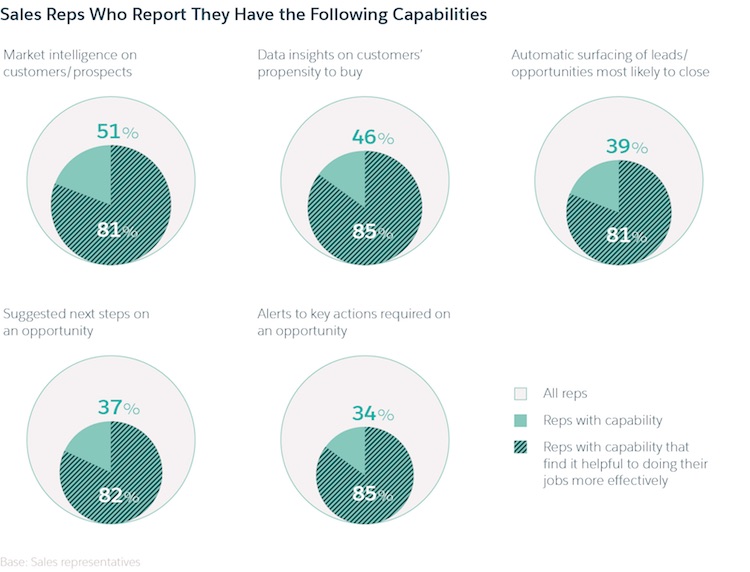
How can you balance human skills and data insights through the sales funnel?
The aim of your sales funnel is to convert prospects into customers — as opposed to a sales pipeline, which is about generating opportunities and deals. It’s a subtle but important difference. The sales funnel is all about people — a nuance that’s important to remember as we increasingly focus on data.
As “State of Sales” finds, salespeople believe a combination of human skills and data-driven insights is needed to convert prospects into customers. In fact, the ability to listen is seen by 78% of those surveyed as an important attribute needed for landing deals. But sales reps also have to demonstrate industry knowledge (74%), trustworthiness (74%), and knowledge of prospects’ business needs (73%).
Other important factors — such as engaging the prospect at the right time (76%) — aren’t always possible without the aid of data-driven tools.
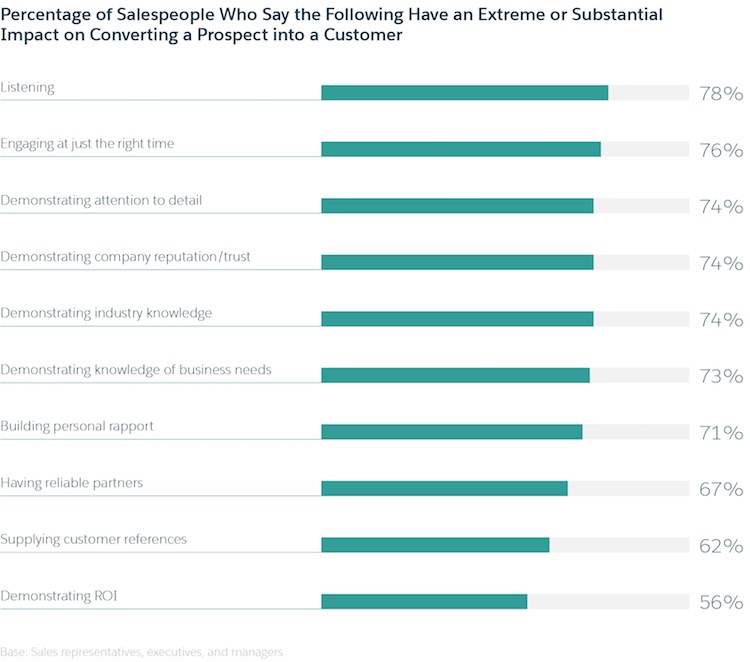
For more insights on the sales funnel, check out the State of Sales report based on global research of 2,900 sales professionals.
This post originally appeared on the U.S.-version of the Salesforce blog.
